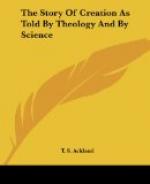It has been shown that Laplace’s Nebular Hypothesis, when substituted for the action of a Creator, broke down in three important points. Of these the first two were, that it failed to give any account of the origin of matter, and of the first commencement of the action of Gravitation. These two defects are completely supplied by the first three verses of Genesis. We may probably see in the “Great Nebula” in Orion an illustration of the condition of the solar system when light first made its appearance. It is very probable that that nebula has only very recently become visible. Galileo examined Orion very carefully with his newly invented telescope, but makes no mention of it. [Footnote: Webb’s Celestial Objects, p. 255, note.] At present it is visible to the unaided eye even in England, where the atmospheric conditions and its low altitude are alike unfavourable. In Italy, where the atmosphere is remarkably pure, and the meridian altitude is greater by 7 1/2 degrees, it must be a conspicuous object, and had it been so at the time when Galileo was observing the constellation, it could hardly have failed to attract his attention. It was, however, noticed in 1618. It is a vast, shapeless mass, having its boundaries in some parts tolerably well defined, while in other directions it fades away imperceptibly; its light is very faint, and when examined by the spectroscope is found to proceed from a gaseous source. Professor Secchi has traced it through an extent of 5 degrees. When it is remembered that at such a distance the semi-diameter of the earth’s orbit subtends an angle less than 1 inch, some idea of the enormous extent of this mass of gas may be formed. Drawings of it have been made from time to time by our most distinguished astronomers, which are found to differ considerably. Great allowance must, of course, be made for differences in the telescopic power employed, and in the visual powers of the several observers, but the differences in the drawings seem too great to be explained by those sources of inaccuracy alone, and actual change in the nebula is therefore strongly suspected. Another nebula of similar character, in which changes are suspected, is that which surrounds the star A in the constellation Argo. This is being very carefully watched through the great telescope recently erected at Melbourne, and from the observations made there, it is probable that fresh light may soon be thrown on the subject.




